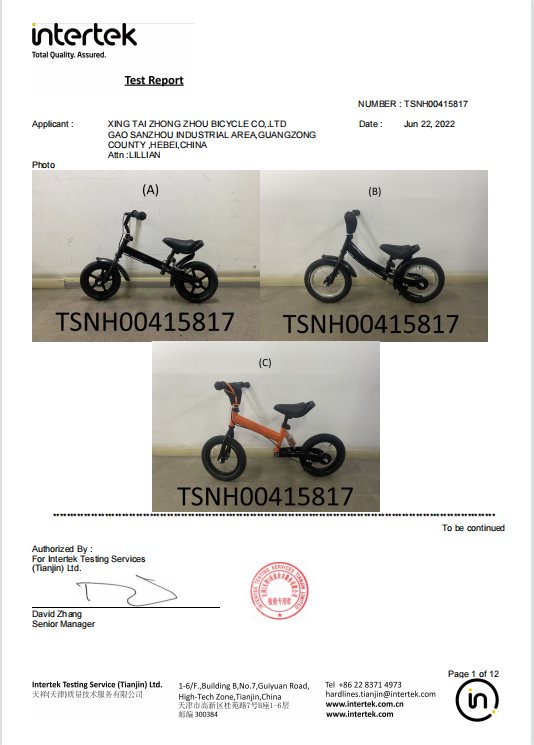Understanding the Different Sizes of Children's Bicycles for Optimal Fit and Comfort
Understanding Kids' Bike Sizes A Guide for Parents
Choosing the right bike for your child is crucial for their comfort, safety, and enjoyment. Kids' bikes come in various sizes, designed to accommodate different age groups and physical abilities. Understanding these sizes can help parents make informed decisions when selecting the perfect bike for their little ones. This guide will detail the primary factors influencing bike size and provide advice on how to find the right fit for your child.
1. Age and Height
Bikes are generally categorized by wheel size, which corresponds to the child's age and height. The most common wheel sizes for kids' bikes range from 12 inches to 24 inches, with the following general age and height guidelines
- 12-inch wheels Typically suited for children aged 2 to 4 years, with a height range of 30 to 39 inches. These bikes often come with training wheels to provide stability as the child learns to ride.
- 14-inch wheels Best for kids aged 3 to 5 years, standing between 36 and 42 inches tall. These bikes may also include training wheels, though some might be designed for advanced little riders who are ready to balance independently.
- 16-inch wheels Ideal for children aged 5 to 7 years, who are generally between 42 and 48 inches tall. At this stage, many kids can start riding without training wheels, as they develop more balance and coordination.
- 20-inch wheels Suitable for 6 to 9-year-olds, with a height range of 48 to 54 inches. These bikes are often designed for slightly more adventurous riding and may come in a variety of styles, including BMX bikes.
- 24-inch wheels Designed for kids aged 8 to 12 years, typically measuring between 54 and 60 inches tall. Bikes of this size often resemble adult models and can be used for both casual riding and more serious biking activities.
2. Inseam Measurement
While age and height are important, inseam measurement is perhaps the most critical factor in determining the right bike size. Measure your child's inseam by having them stand barefoot against a wall, feet slightly apart. Measure from the floor to the highest point of their crotch. To find the correct bike size, use the following guidelines
sizes of kids bikes

- For a bike with 12 to 16-inch wheels, your child's inseam should be at least 14 inches
.- For a bike with 20-inch wheels, an inseam of 22 to 24 inches is recommended.
- For 24-inch bikes, the inseam should be around 24 to 28 inches.
These measurements ensure that when your child sits on the bike, they can comfortably touch the ground with their feet, providing balance and control while riding.
3. Adjustability and Growth
Kids grow quickly, making it essential to choose a bike that offers adjustability. Look for models with adjustable seat heights and handlebars. This feature allows you to accommodate your child’s growth, extending the bike's lifespan. Additionally, some bikes have features like quick-release clamps that make it easier to adjust as needed.
4. Safety Considerations
Safety is paramount when selecting a bike for your child. Ensure that the bike is equipped with appropriate safety features, including a reliable braking system, reflective elements, and a sturdy frame. A helmet should always accompany bike riding; selecting a bike that fits well is just as essential as the proper safety gear.
Conclusion
Choosing the right bike for your child involves considering their age, height, inseam measurement, and potential for growth. By understanding these factors and assessing multiple bike sizes, parents can ensure their children have a safe and enjoyable riding experience. Investing in the right-sized bike not only enhances your child's skills and confidence but also instills a lifelong love for biking. So gear up, measure right, and let the adventures begin!
-
kids-scooter-tiny-olympic-games-scooterathlonNewsAug.22,2025
-
kids-scooter-waves-xingtai-zhongzhous-global-rippleNewsAug.22,2025
-
baby-tricycle-oem-legacy-zhongzhou-forgedNewsAug.22,2025
-
xingtais-twin-tricycle-revolution-siblings-ride-togetherNewsAug.22,2025
-
baby-tricycle-design-inspired-by-ancient-armorNewsAug.22,2025
-
nfc-chip-enabled-oem-baby-tricycle-trackingNewsAug.22,2025
-
The Perfect Baby TricycleNewsAug.11,2025








